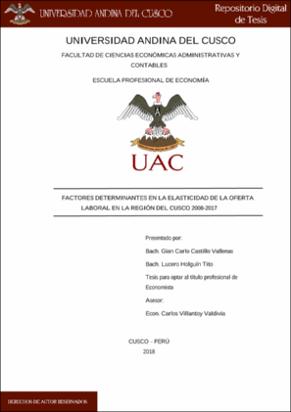| dc.contributor.advisor | Villantoy Valdivia, Carlos | |
| dc.contributor.author | Castillo Vallenas, Gian Carlo | |
| dc.contributor.author | Holguín Tito, Lucero | |
| dc.date.accessioned | 2019-03-01T20:02:14Z | |
| dc.date.available | 2019-03-01T20:02:14Z | |
| dc.date.issued | 2018-11-07 | |
| dc.identifier.uri | https://hdl.handle.net/20.500.12557/2275 | |
| dc.description.abstract | En el presente trabajo se estimó la elasticidad de la oferta laboral y los factores
determinantes de esta en la Región Cusco en el periodo 2008-2017. La elasticidad de la
oferta laboral mide la variación de las horas trabajadas frente a una variación en los
salarios, la que a nivel macroeconómico tiene efectos en la riqueza, según Céspedes y
Rendón (2012). La estimación se hizo utilizando el modelo pooling cross sections,
haciendo uso de los datos obtenidos de la encuesta nacional de hogares (ENAHO) anual.
Tras correr el modelo de la investigación se obtuvo una elasticidad de la oferta laboral de
aproximadamente 0.42, es decir, ante un incremento de 10% en los salarios se incrementa
en 4% las horas trabajadas; y que los factores determinantes de la elasticidad de la oferta
laboral en la región son la Remuneración mínima vital con un efecto negativo, y el nivel
educativo con un efecto positivo de acuerdo al grupo educativo, lo que indica que para las
personas que perciban una remuneración mayor a la RMV ante un incremento de sus
salarios se tiene un menor incremento en las horas trabajadas que para las personas que
ganan menos de la RMV, en tanto para aquellos que cuentan con un nivel de educación
mayor un incremento en sus salarios se traduce en un menor incremento de horas
trabajadas que para aquellos que cuenten con un menor grado educativo. | es_PE |
| dc.description.abstract | In the present work were estimated the elasticity of the labor supply and the determining
factors of this in the Cusco Region in the 2008-2017 period. The elasticity of the labor
supply measures the variation of the hours worked as opposed to a variation in wages,
which at the macroeconomic level has an effect on wealth, according to Céspedes and
Rendón (2012). The estimation was made using a pooling cross sections model, making
use of the data obtained from the annual national household survey (ENAHO).
After running the research model, an elasticity of the labor supply of approximately 0.42
was obtained, that is to say, in the case of a 10% increase in wages, hours worked
increased by 4%; and the determinants of the elasticity of the labor supply in the region are
the minimum vital remuneration with a negative effect, and the educational level with a
positive effect according to the educational group, which indicates that, for the people who
receive a remuneration higher than the RMV in the face of an increase in their salaries
there is a smaller increase in hours worked than for people who earn less than the RMV,
while for those who have a higher level of education an increase in their salaries translates
into a lower increase in hours worked than for those who have a lower educational level. | en_US |
| dc.description.uri | Tesis | es_PE |
| dc.format | application/pdf | es_PE |
| dc.language.iso | spa | es_PE |
| dc.publisher | Universidad Andina del Cusco | es_PE |
| dc.rights | info:eu-repo/semantics/openAccess | es_PE |
| dc.rights.uri | https://creativecommons.org/licenses/by-nc-nd/2.5/pe/ | es_PE |
| dc.source | Universidad Andina del Cusco | es_PE |
| dc.source | Repositorio Institucional - UAC | es_PE |
| dc.subject | Elasticidad--Oferta laboral | es_PE |
| dc.subject | Horas de trabajo | es_PE |
| dc.subject | Salario | es_PE |
| dc.title | Factores determinantes en la elasticidad de la oferta laboral en la Región del Cusco 2008-2017. | es_PE |
| dc.type | info:eu-repo/semantics/bachelorThesis | es_PE |
| thesis.degree.name | Economista | es_PE |
| thesis.degree.grantor | Universidad Andina del Cusco. Facultad de Ciencias Económicas, Administrativas y Contables | es_PE |
| thesis.degree.level | Titulo Profesional | es_PE |
| thesis.degree.discipline | Economía | es_PE |


